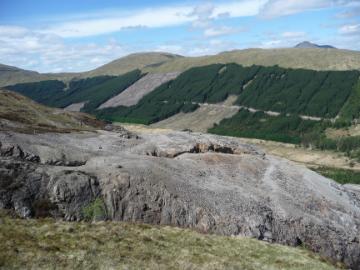Environmental and Occupational Exposure to Heavy Metals Poisoning
Environmental and Occupational Exposure to Heavy Metals: Scottish Lead Mining in the Eighteenth and Nineteenth Centuries
The project examines historic occupational and environmental lead poisoning amongst the labour force and adjacent population at Leadhills mine in the Scottish southern uplands (see image: Wilson Shaft Lead Mine, Leadhills). Particular emphasis is placed on identifying the historic health risk factors specific to the mining environment at Leadhills comparative to the lead mining venture at Tyndrum.

The study extends the recent historical and geo-archaeological study of the historical relationship between mining, pollution and health at Tyndrum which suggested that surface labour at the dressing floor were regularly exposed to lead concentrations around one thousand times higher than established background levels. Yet in contrast to Leadhills, and also the wider English and Welsh lead mining industries, there are very few recorded incidents of either chronic or acute lead poisoning, and little evidence of concern for grazing livestock. Leadhills mine was highly productive raising an average of 2, 000 tons of lead ore annually across its period of operation, compared to the 424 tons produced during Tyndrum’s peak years of operation. Accordingly, lead pollution values were around 100 times greater at Leadhills than at the Tyndrum site. The comparatively lower values may potentially explain the absence of poisoning amongst Tyndrum’s workforce. It is possible that poisoning amongst Tyndrum’s workforce was simply not recorded and symptoms may have been lost amongst the background noise of general ill-health and poor living conditions rather than absent. Lead poisoning is notorious difficult to diagnose; symptoms of mild chronic exposure are vague and non-specific, such as gastro-intestinal disturbance and headache. There were, however, working practices and social conditions at Tyndrum that may have reduced occupational and environmental exposure to lead.
These distinctive conditions include the absence of women and large numbers of children at the ore dressing floor which is in contrast to wider British context. Children are particularly susceptible to poisoning and exposure in women often causes gynaecological disorders. Studies of English and Welsh metal mines suggest a marked deterioration in occupational health with the introduction of steam power and continuous working. The venture at Tyndrum, in contrast, was wholly reliant on water power up until the early twentieth century. Hard frosts and floods in winter and drought in the summer months coupled with the need to cut hay and peat for around two months every year produced a seasonal pattern of operation. This may have limited exposure to the contaminated environment and allowed the body time for recovery. Finally there is the question of the miners’ diet. Diet is implicated in the bioavailability of lead. Absorption by the gut is hindered by a high intake of calcium and iron and the community at Tyndrum may well have effectively consumed a ‘protective’ diet’ that primarily consisted of dairy products alongside oatmeal, other grains and kale. The presence or absence of these variables needs to be established at Leadhills before any further conclusions can be drawn.
The study focuses on four key themes in Leadhills history of operation: these include employment practices; patterns of working and sources of motive power; diet and social conditions. Although the research is primarily historical, some environmental investigations are planned to supplement existing studies into the presence of lead compounds and their toxicity at the dressing floors at both the Tyndrum and Leadhills mine sites. The ore worked across the British industry was primarily lead sulphide (galena) which has a relatively low bioavailability and less likely to result in acute toxicity. It was not unknown, however, for miners to encounter pockets of other compounds such as lead carbonate (cerussite) which is soluble in water and readily breaks down into a fine powder that can be easily inhaled. The apparent differences in incidence of historic poisoning between the two sites may also be simply explained by the presence of differing lead compounds. The adoption of an integrated approach will enable a quantitative, as well as an historical assessment of occupational risk to be made between the two sites.
The project is funded by The Carnegie Trust for the Universities of Scotland.
For further information contact Dr. Catherine Mills c.j.mills@stir.ac.uk
